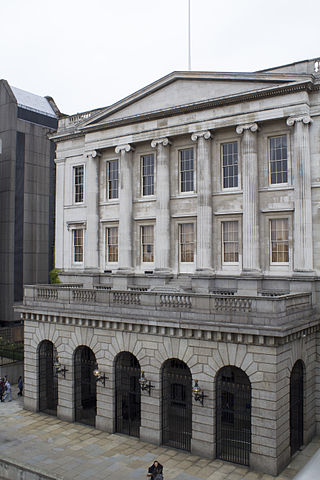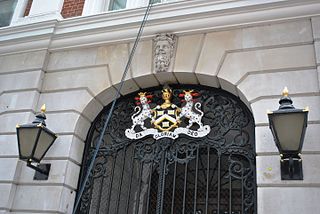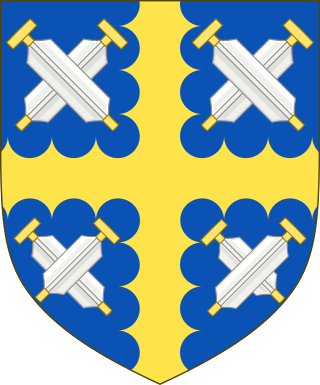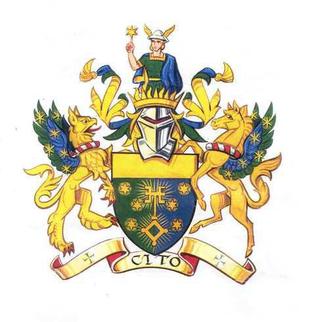Arms
 |
|
The Worshipful Company of Broderers is one of the livery companies of the City of London. Broderers were workers in embroidery; the organization of Broderers existed in at least 1376, and was officially incorporated by a royal charter in 1561. As the craft of embroidery has lost its importance as a trade, the company has become less of a trade association for broderers. Instead, the company is now, as are most livery companies, a charitable foundation.
The company is the forty-eighth in the order of precedence for livery companies. Its motto is Omnia Desuper, Latin for All From Above.
The livery hall of the Broderers, Broderers' Hall, stood on Gutter Lane from 1515 until its destruction in the London blitz. [1] The Broderers now dine in Mercers' Hall. [2]
 |
|

A livery company is a type of guild or professional association that originated in medieval times in London, England. Livery companies comprise London's ancient and modern trade associations and guilds, almost all of which are styled the "Worshipful Company of" their respective craft, trade or profession. There are 111 livery companies in total. They play a significant part in the life of the City, not least by providing charitable-giving and networking opportunities. Liverymen retain voting rights for the senior civic offices, such as the Lord Mayor, Sheriffs and Common Council of the City Corporation, London's ancient municipal authority with extensive local government powers.

The Worshipful Company of Vintners, one of the Great Twelve City Livery Companies, retains close links with the wine trade.

The Worshipful Company of Dyers is one of the Livery Companies of the City of London. The Dyers' Guild existed in the twelfth century; it received a Royal Charter in 1471. It originated as a trade association for members of the dyeing industry but is now mainly a charitable institution. Each year the company participates in the ceremony of Swan Upping along the River Thames.

The Worshipful Company of Cutlers is one of the ancient Livery Companies of the City of London. It ranks 18th in the order of precedence of the Companies.

The Worshipful Company of Pewterers is one of the 111 Livery Companies of the City of London. It ranks 16th in the order of precedence of City Livery Companies and has existed since at least 1348. Like all the other City Livery Companies, the Worshipful Company of Pewterers has four main pillars of activity: Charitable endeavour, assistance to education, support for its trade and profession, and being a convivial and caring social community.

The Worshipful Company of Armourers and Brasiers is one of the livery companies of the City of London. The Armourers' Guild was established in 1322; it received a royal charter in 1453. Other companies, including the Armour Repairers, merged with the Armourers. In 1708, brass workers joined the company, which was renamed as the Armourers' and Brasiers' Company. The company does support the metallurgy industry, but does not retain a close association with its original trade, as is the case with a majority of livery companies. It exists primarily as a charitable establishment.

The Worshipful Company of Cordwainers is one of the Livery Companies of the City of London. Cordwainers were workers in fine leather; the Company gets its name from "cordwain" (cordovan), the white leather produced from goatskin in Cordova, Spain. All fine leather makers, including Girdlers and Glovers, were originally classified as cordwainers; however, the term eventually came to refer only to fine leather footwear, including boots.

The Worshipful Company of Glovers is one of the ancient Livery Companies of the City of London. Glovers separated from the Cordwainers to form their own organisation in 1349 and received a Royal Charter of incorporation in 1639. The company is, as are most other Livery Companies, a charitable body, but it still retains close links to its original trade.

The Worshipful Company of Carpenters is a livery company of the City of London. The Carpenters were traditionally different from a fellow wood-crafting company, the Worshipful Company of Joiners and Ceilers, in that carpenters utilised nails while joiners used adhesives to attach wood.

The Worshipful Company of Curriers is one of the ancient livery companies of London, associated with the leather trade.

The Worshipful Company of Masons is one of the ancient Livery Companies of the City of London, number 30 in the order of precedence of the 110 companies. It was granted Arms in 1472, during the reign of King Edward IV; its motto is “God Is Our Guide”.

The Worshipful Company of Coopers is one of the livery companies of the City of London. The organisation of coopers existed in 1422; the Company received its first royal charter of incorporation in 1501. The cooper trade involved the making of wine, beer, and spirit casks ; the Livery Company also functions as a charitable foundation, and supports two education establishments: the Coopers' Company and Coborn School of Upminster, Essex, and Strode's College of Egham, Surrey. The former was founded in the Ratcliffe area of London in 1536 and donated to the Company who have been involved with it ever since.
The Worshipful Company of Framework Knitters is one of the livery companies of the City of London. It was incorporated by letters patent issued by Oliver Cromwell in 1657, with a Royal Charter from Charles II in 1663. It was granted livery status in 1713. For a period it had its own hall in Red Cross Street, however for various reasons it was sold.
The Worshipful Company of Fan Makers is one of the Livery Companies of the City of London. The company was incorporated by a Royal Charter in 1709. As fan making is now done by machines rather than by craftsmen, the company is no longer a trade association for fan makers. Instead, the Company functions as a charitable establishment.
The Worshipful Company of Tobacco Pipe Makers and Tobacco Blenders is one of the Livery Companies of the City of London. The Company ranks 82nd in the order of precedence of the Companies. It does not have its own livery hall but is peripatetic, meeting instead at halls of various other Livery Companies.

The Worshipful Company of Information Technologists, also known as the Information Technologists' Company, is one of the livery companies of the City of London. The company was granted livery status by the Court of Aldermen on 7 January 1992, becoming the 100th livery company. It received its Royal Charter on 17 June 2010 from Prince Edward.
Mercery (from French mercerie, meaning "habderdashery" or "haberdashery" initially referred to silk, linen and fustian textiles among various other piece goods imported to England in the 12th century. Eventually, the term evolved to refer to a merchant or trader of textile goods, especially imported textile goods, particularly in England. A merchant would be known as a mercer, and the profession as mercery.

English embroidery includes embroidery worked in England or by English people abroad from Anglo-Saxon times to the present day. The oldest surviving English embroideries include items from the early 10th century preserved in Durham Cathedral and the 11th century Bayeux Tapestry, if it was worked in England. The professional workshops of Medieval England created rich embroidery in metal thread and silk for ecclesiastical and secular uses. This style was called Opus Anglicanum or "English work", and was famous throughout Europe.
The Broderers' Hall or Embroiderers' Hall at 36 Gutter Lane was the livery hall of the Worshipful Company of Broderers, the City of London livery company for embroiderers from 1515 until its destruction in 1940.

Cordwainers' Hall was the livery hall of the Worshipful Company of Cordwainers, the City of London livery company for Cordwainers from 1316 until its destruction in 1941.